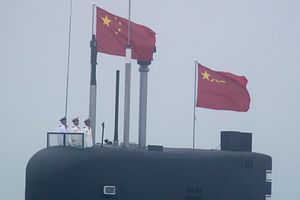As China’s navy hurtles forward to unprecedented levels of both numbers and capability, several key questions are naturally surfacing in all corners of the world.
First, what is China’s true intent? Second, can it bear the cost of military expansion, which comes in addition to its Belt and Road Initiative (BRI) loan commitments and infrastructure building around the world, particularly at a time of slowing growth and a trade war with the United States? Will the Chinese people themselves accept the new role, and the cost of that role, that Xi Jinping is carving out for them in Asia, and beyond?
Finally, can China’s military buildup, as evidenced this week by the 70th anniversary of the establishment of the People’s Liberation Army Navy (PLAN), manage to avoid the pitfalls that other nations in other times have met when they expanded their militaries in peacetime?
The PLAN anniversary was celebrated in foggy, rain-soaked Qingdao and environs over four days of sea parade and festivities, ending on April 25. The South China Morning Post reports that “delegations from more than 60 countries and 18 vessels from more than 13 countries including Japan, the Philippines, Russia, and South Korea” joined the event. Vietnam and India also sent vessels. China has areas of territorial conflict and disagreement – especially in the South China Sea — with many of the nations that sent vessels.
The United States did not join in the celebrations.
Navies, as projections of power, face risks when they are built up during peacetime, says Steven Wills in an article for the Center for International Maritime Security. Put simply, the argument is that the military assets that are commissioned during a peacetime buildup risk becoming obsolete by the time they may need to be put to use. Technologies advance, and if the gap in years between the creation of capability and its actual wartime operation is too wide, the other side will likely have the developmental edge.
Wills’ thesis centers on peacetime naval build ups in free societies; is there necessarily a different outcome with authoritarian ones?
The Chinese, who are as astute as anyone in analyzing strategies and probabilities, have certainly considered the questions and risks of peacetime expansion. They will have factored their conclusions into their unprecedented expenditure in building a world-class military, including a navy that they hope can dominate in Asia and replace the United States in the Pacific, once and for all. They will not have knowingly plowed new, hard-won treasure into a purely vanity project.
One logical conclusion, then, is that China plans to use this navy in combat — a combat of their choosing. And it plans to do so before what the PLAN has built to date becomes obsolete.
The alternative conclusion would be to assume that China, as a one-party, authoritarian state stubbornly holding on to strong-arm methods of controlling its people, simply wants to have “symbols” of its power and prestige to prove and enforce its legitimacy. This analysis puts the military, including its navy, into a context of extremely expensive toys that act as props, both literal and figurative, to support the Chinese Communist Party — live-fire toys that you can bring out and play with from time to time, but which you would never really use.
That’s a very dangerous assumption. As manipulative as the CCP can be, and even with as much power as Xi Jinping appears to have consolidated under his control, the pushback he would face from within the Party to making outlandish and irrational expenditures that are simply not needed would be sufficient to prevent his ability to make them – if the Party powerful wholly disagreed.
The plain fact that he is making these investments should suggest to observers that there is consensus within the CCP to do so. And that means that there is consensus to put China on a war footing.
Analysts of China’s military expansion should read the tea leaves that are there. It does not make sense to say that Beijing is building its navy, and its military as a whole, just to prove a point to the rest of the world – and to itself – that China has arrived. The breadth and depth of this military and naval build up is more than a method to assuage China’s own hurt feelings from past humiliations by foreign powers. Analysts and policymakers would do well to keep in mind the fundamentally pragmatic side of Chinese, and CCP, culture. They would also be wise to take China at its word. In this case, the word comes in the form of naval ships and capability that match some of the world’s best, and in some cases exceed it.
John Maurer at the U.S. Naval War College asks the question, “Is China Repeating Germany’s World War I Mistakes?” The biggest of those mistakes was misjudging Britain, which the German rise was meant to counter, by believing that the German “navy would act to deter Britain from contesting German political ambitions on the world stage. London would back down in any confrontation with Berlin rather than risk losing a war at sea and, along with it, the British Empire.”
To the contrary, the German naval build up sparked a naval arms race of enormous proportions. Ultimately, Maurer reminds us, the German regime that built the navy was destroyed by the application of it.
But not before, however, Europe and beyond was wrought with war, destruction, and death. A hundred years later, global policymakers need to create a coordinated, unambiguous response to China’s naval and other military buildup, before past outcomes become future realities.

































